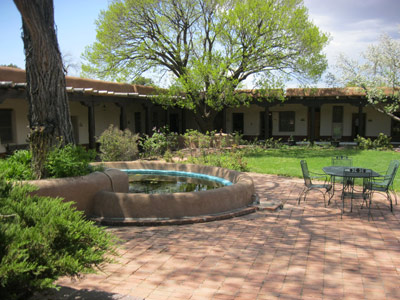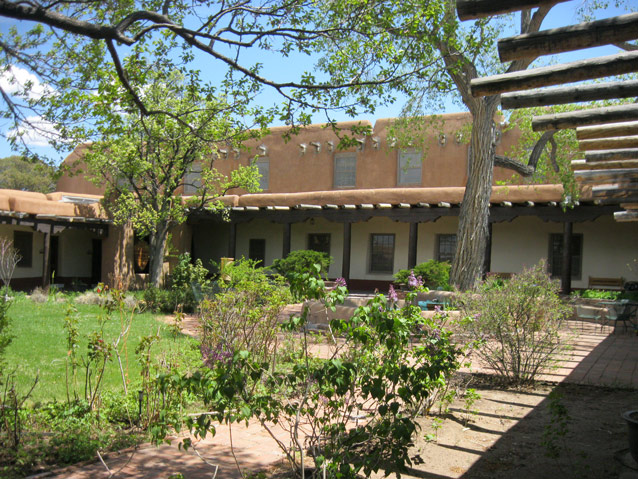
NPS Photo/C. Mardorf
Founded in 1610, Santa Fe, New Mexico is home to a lot of great attractions and amenities that make it a top tourist destination in the United States—amazing food, world-class museums, quirky art galleries, a large farmers market, an open-air opera, and hundreds of public, outdoor recreational areas in the nearby Sangre de Christo and Jemez Mountains. But nestled within the City Different are a plethora of hidden gems that are less visited and less well-known.
Hidden in plain sight on Museum Hill at the intersection of Old Santa Fe Trail and Camino de Monte Sol, the Region III Headquarters building (also known as the Old Santa Fe Trail building) is home to approximately 70 employees of the Intermountain Regional Office of the National Park Service. The building, built in the 1930s with New Deal era labor, is a large, unimposing adobe structure, supposedly the largest adobe office building within the United States.

NPS Photo/C. Mardorf
In addition to the unique architectural style that blends into the surrounding landscape, the building features a series of courtyards and exterior adobe and stucco walls that comprise its cultural landscape. The largest courtyard features a fountain and pond, brick patio, turf grass panel, and plantings, including one of the largest apricot trees in New Mexico, surrounded by a covered portal (exterior covered walkway) that lead to office spaces. Other courtyards are less elaborate, but provide pleasant views and outdoor spaces adjacent to offices. Surrounding the building, parking areas are screened from view by low adobe walls, pinion-juniper woodland, native shrubs, and grasses.

NPS Photo/C. Mardorf
A Cultural Landscape Report was completed for the building and landscape in April 2011, which outlines recommendations for future stewardship of the property. The report recommends restoring the exterior landscape and main courtyard to its original design intent; selectively removing undergrowth to open up views and reduce wildland fire fuel loads; and removing non-native, invasive plant material. Rehabilitating the low, adobe walls is also recommended, and the National Park Service (NPS) is currently working to secure funds to restucco the main building to ensure its continued preservation.

NPS Photo/C. Mardorf
South and northwest of the building, in not-so-plain sight, are ruts and remnants of the Santa Fe Trail. As the namesake of the nearby NPS regional office building and current-day street that roughly follows its alignment, the trail was a trade corridor and commercial highway between Missouri and Santa Fe from 1821 to 1880. Prior to 1846, the route opened trade into what was then Mexico, and later provided the Army of the West with a route to invade the region during the Mexican-American War, eventually claiming portions of the Southwest for the United States. The route was designated as a National Historic Trail in 1987.
Today, the weight of the wagons and livestock transported over the corridor are evident in depressions and ruts across portions of Missouri, Kansas, Colorado, Oklahoma, and New Mexico. To make segments of the trail more visible and accessible to visitors, the NPS National Trails program is working to design interpretive signage for the ruts and depressions near the Old Santa Fe Trail building.

NPS Photo/C. Mardorf
Both the Santa Fe Trail National Historic Trail and current-day street named Old Santa Fe Trail terminate in one of the more visible cultural landscapes of the city—Santa Fe Plaza. The open green space in the heart of downtown is marked by a covered bandstand, American Indian War Memorial, Santa Fe Trail marker, axial walkways, and overstory trees. Surrounded by historic buildings and museums in the Pueblo, Spanish, and Territorial styles, the Plaza is vibrant public space often filled with tourists and residents at all times of the year.
Visiting this Landscape
Contact: (505) 988-6757
Guided Tours: Public tours are not available; however, an NPS brochure is available that discusses the history of the building and property. The Santa Fe Trail ruts are located within walking distance of the south and northwest of the building.
Fees: Free
Access: The Old Santa Fe Trail Building is open to the public from 10 AM to 5 PM Monday to Friday. Visitors must sign in at the front desk and wear visitor badges when inside the building.
Santa Fe Plaza is a public open space owned by the City of Santa Fe, open year round.
Last updated: January 11, 2016
